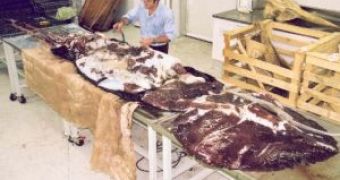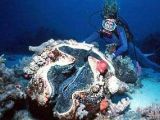1. There are 80,000 species of living mollusks, classified in Gastropoda (snails and slugs), Bivalvia (clams, oysters and scallops), Cepahlopoda (squids, cuttlefish and octopuses), Scaphopoda, Polyplacophora (chitons), Aplacophora, Monoplacophora, Caudofoveata. Because most mollusks have hard shells, many were fossilized, and over 35,000 fossil species are known.
Mollusks have an external flexible cover tissue called mantle, well developed circulatory and nervous systems. They reproduce sexually, having separate genders or being hermaphrodite (like many snails and Bivalvia). The shell is made by the mantle by calcium carbonate extracted from the water. It is used for floating or as shelter. The mollusk body is made by head, body and foot. The head may have tentacles and eyes. The mouth contains radula, a grinding organ provided with multiple sets of teeth. The anus and excretory orifices open in the cavity of the mantle.
2. Sea rabbits are just shell devoid sea snails. They are frequent in coral reefs and posses iridescent color and feed on coral polyps, sponges and sea anemones. Most shelled sea snails live on or close to the bottom of the sea, feeding on algae, bacteria and fungi found on stones. In the tide area, many snails are carnivorous. World's largest snail is the Australian trumpet (Syrinx aruanus), a sea species from the shores of northern and western Australia which can grow up to 77.2 cm (30 inches) in shell length, while the flesh weighs up to 18 kg (40lbs). It feeds on sea stars and sea cucumbers and it is rare now, being intensively collected.
Each female of sea snail produces about 2,000 egg capsules and each capsule contains about 1,000 eggs. The capsules are sticky and adhere one to another, forming "sea balls". From the about 1,000 eggs of capsule, around 30 offspring hatch, eating the rest of the eggs and each other as well, so that in the end each capsule produces 10 new snails. Some snails tolerate various levels of salinity, being encountered both in brackish and freshwater. Abalones are snails with respiratory holes at the edge of their shell.
3. Bivalves have double shell, articulated through an extremely strong and flexible ligament, which can be relaxed to allow the opening of the shell, facilitating the entrance and exit of the water. When the bivalve is attacked, the muscle maintains the shells tight. Bivalves feed on detritus and floating organic matter, sucked through a frilled siphon on the edge of the shell. Water is expelled through a smaller siphon.
Some freshwater mussels release larvae called glochidia which float in the water and attach to the gills of a fish called bitterling. The larvae turn here in small clams that leave the fish and start their life at the bottom of the lake. Instead, the bitterling span its eggs only on the mantle cavity of the mussel, where the developing eggs are protected.
The giant clams Tridacna form a symbiosis with the Zooxanthella algae: algae live in the clam's tissues, where transparent cells focus light on Zooxanthella which turns the wastes of the host into sugar through photosynthesis. This way, the giant clams can be found only at depths down to 20 m (66 ft) in the reefs, where their symbiotic algae can make 6 photosynthesis. These clams live at least 100 years and Tridacna gigas can be 1.37 m (4.5 ft) long, weighing 20 kg (44 pounds) (this is the largest shelled mollusk in the world). Tridacna are menaced, as they are heavily exploited, their meat being appreciated.
In king scallops, the edge of the shell has tentacles and eyes. When the eyes detect a predator, the animal executes a backward jet motion by suddenly expelling the water out of its mantle cavity.
4. Cephalopod fossils are known from 500 million years ago. They have specialized tentacles around the mouth, provided with caps and hooks, and well developed eyes. The mantle cavity is funnel shaped, being developed for propelling the animal backwards at high speed, due to the sudden expulsion of water. Squids can reach 55 km (35 mi) per hour, and can jump of the water at this speed.
Abyssal squids can be over 12 m (40 ft) long and weigh up to 6 tons. They form the main food of the sperm whales. It is estimated that sperm whales and seals eat annually about 10 million tons of squids.
Cephalopods possess parrot-like beaks, and all octopuses are venomous (some more than the others). Octopuses cannot tolerate each other and mating is made through the tentacles. In males, one tentacle functions like a penis, and through a groove of this tentacle, the male transfers a spermatophore (sperm capsule) to the female. The female lays about 150,000 eggs guarded by her for about 6 weeks till the hatch time, when she dies.
Octopuses have 8 tentacles; squids and cuttlefish have extra two, longer than the others, which spring forward to grab the prey with their caps. The long tentacles stay in resting position into a cavity beneath the eyes of the animal. Squids and cuttlefish also have lateral fins. Octopuses are totally devoid of shell, while cuttlefish and squids still keep an inner shell, with a role in floatability. All cephalopods possess skin cromatophores that enable them to change color and mimic their environment.
The most primitive living cephalopod, Nautilus, had 90 tentacles and a fully developed shell, like in snails, used as shelter and for floatability.
5. Chitons live in shallow waters; they have 8 overlapped calcareous plates on the dorsal part and on the ventral part. A groove contains several gill pairs. Chitons feed during the night, chopping algae and other plant matters with their toothed radula. When disturbed, the chiton rolls like a hedgehog.
6. There are 70 species of Caudofoveata, all looking like worms and feeding on microbes and floating organic matter on the sea bottom. The body is covered by a protective tough scaled skin.
Scaphopoda live buried in sediments, have bilateral symmetry and a curbed shell opened at both ends. The thin end goes out of the sand, and though it, water currents allow respiration and excretion. They feed on Foraminifera (a type of protozoa) catching them with their trunk and head's tentacles and crashing them with their radula. Solenogastra do not have shell and they never had. They look like flat worms and feed on polyps.
7. Pearls and mother of pearls are produced by mollusk shells. Pearls emerge when a foreign body, like a sand grain or parasite remains between the two shells of a bivalve. The object is wrapped by calcium carbonate till it gets isolated from the bivalve's body. By introducing artificially a small piece of material into the body of a bivalve, a small pearl is made at command.
Mother-of-pearl, the inner material of the shells, is used in ornaments and wood embeddings. Shells of Pinctada, Trochus and Turbo are collected in the Pacific.
8. In the Mediterranean, 50 species of bivalves, 12 of snails, and 13 of cephalopods are consumed by humans. 2.3 million tons of oysters are consumed annually. Oysters make 25 % of the farmed mollusks, other species being mussels, scallops and clams. Up to 1.2 million tons of squids and octopuses are fished annually, 50 % by the Japanese.
9. Mollusks have huge neurons, and the sea rabbits are used in studies of memory loss.
Scallops, squids and oysters contain antibacterial and antiviral chemicals and freshwater mussels contain anti-cancer chemicals.
10. Mollusks are menaced by contamination with heavy metals, bacteria from residual waters and wastes, and are extremely sensitive to oil spills. Many impurities can tap the filtering system of the mollusks. Sea dikes, draining off of the estuaries and tourism, impact heavily on mollusks.

 14 DAY TRIAL //
14 DAY TRIAL // 

